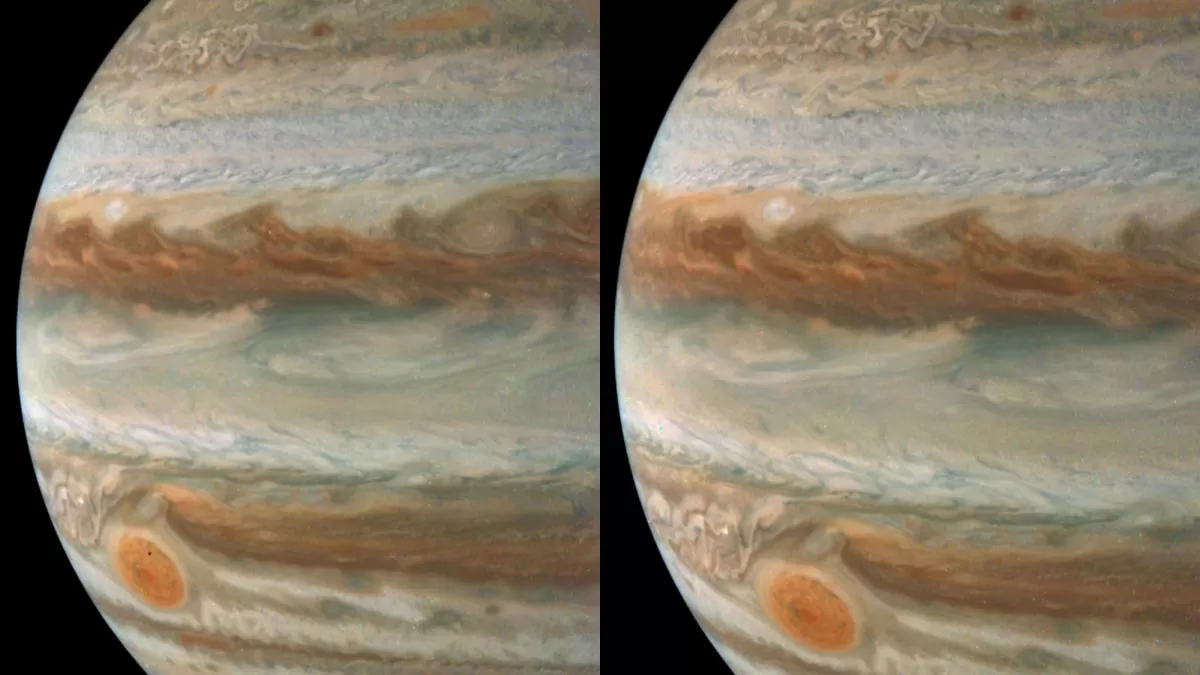NASA’s Juno probe has once again captured stunning images of our solar system’s largest planet, Jupiter. On October 23rd, during its 66th flyby, the probe captured vibrant and high-contrast images of Jupiter’s stormy atmosphere and an up-close view of one of its 79 known moons, Amalthea. These images were then enhanced and processed by citizen scientists, providing a unique and unparalleled view of the giant gas planet and its enigmatic moon.
The Juno probe, launched in August 2011, is a part of NASA’s New Frontiers program and aims to study Jupiter’s origin, structure, and evolution. The spacecraft, equipped with nine cutting-edge instruments, travels through the harsh radiation belts surrounding Jupiter and dives into its atmosphere to collect data and images.
During its latest flyby, Juno captured images of Jupiter’s southern hemisphere and its distinct cloud formations, including the Great Red Spot – a storm that has been raging for centuries. The images, when processed by citizen scientists, revealed vivid and striking colors, bringing out the unique features of Jupiter’s turbulent atmosphere. The Great Red Spot, which is twice the size of Earth, is a constant reminder of the sheer size and power of the gas giant.
But it wasn’t just Jupiter’s stormy atmosphere that Juno captured, it also provided a close-up view of Amalthea, one of the smallest and most irregularly shaped moons in our solar system. Amalthea, named after the nymph who raised Zeus in Greek mythology, is a small but fascinating moon, with a diameter of just 268 kilometers.
The images of Amalthea, captured from a distance of 76,000 kilometers, give a glimpse of its rugged and pockmarked surface, indicating a history of impacts from other celestial bodies. Its rocky and elongated shape makes it stand out against the backdrop of Jupiter’s magnificent clouds in the background.
But what makes these images even more special is the contribution of citizen scientists in processing them. Through NASA’s JunoCam website, the public is invited to participate in the mission by voting on which areas of Jupiter the probe should capture images of. The raw images are then made available for processing, providing the public with an opportunity to enhance them and showcase their creativity in revealing Jupiter’s beauty.
The latest images of Jupiter and Amalthea are a testament to the success of this unique collaboration between scientists and citizens. The enhanced images showcase the vibrant colors and features of the gas giant, providing a rare and breathtaking view of our neighboring planet.
In addition to capturing stunning images, Juno’s mission also aims to study Jupiter’s atmosphere, magnetic field, and gravitational field in detail, unraveling the mysteries of its formation and evolution. The data collected by the probe will help scientists better understand not only Jupiter but also the formation and evolution of our entire solar system.
The Juno mission has already achieved significant milestones since its arrival at Jupiter in July 2016. It was the first spacecraft to capture images of Jupiter’s poles, revealing never-before-seen images of its polar storms and the auroras that light up the planet’s skies. It has also provided insights into the composition and structure of Jupiter’s atmosphere, highlighting its turbulent and constantly changing nature.
But the mission is far from over, and with each flyby, Juno continues to surprise and amaze us with its findings. The images captured by the probe not only inspire wonder and awe but also bring us closer to understanding the vast and complex universe we live in.
As we await more images and data from future flybys, we can marvel at the latest images of Jupiter and its moon, Amalthea, and appreciate the collaboration that has made them possible. NASA’s Juno probe and its citizen scientists have once again reminded us of the beauty and wonder that lies beyond our planet and the importance of working together to explore and understand it.

